Our first glimpse reminded me of Machu Picchu–a Peruvian mystery community–in its landscaping. Jabba (pronounced not like Jabba-the-Hut but the emphasis on the second syllable) was a village built right into the sides of two mountains with a babbling brook trickling through its relatively insignificant valley. These weren’t your typical mountains with a gradual incline; these mountains went straight up. Thus, the villages had learned (a couple of thousand years ago) how to landscape in such a way that levels or tiers were created to support not only their homes but their corn fields as well. I was suprised to discover that this was an agricultural people who survived on the corn and wheat that they were able to grow and harvest before the winter set in.
Jabba was a village of 1500 people and 120 homes. Due to the earthquake, I later discovered that over 300 of their people had died and they had lost 100 of their homes, leaving several hundred people homeless. Many of them were living in donated tents, the old school buildings, or barns that had not fallen. Every building that was left standing was significantly damaged, however, and will likely be torn down and rebuilt once the spring comes.
Imagine this….You have never seen an American before. What’s more, you likely have never seen anything outside of your small village or valley. All of a sudden, a huge flying machine lands in your most spacious corn field. What do you think that must have been like for the people of Jabba?
By the time we landed, there were about 100 men and boys squatting just out of reach of the helicopter blades watching with wide-eyes as this “thing” hovered above them before landing gently into the ice-cold mud below. They must have thought the world was coming to an end–and then the “thing” opened and out came four Americans dressed in colorful jackets.
We were greeted with a wave of ice-cold air, confusion, anxiety, and the warm welcome of Mumtaz–a Pakistani Army Commander who was stationed in Jabba.
